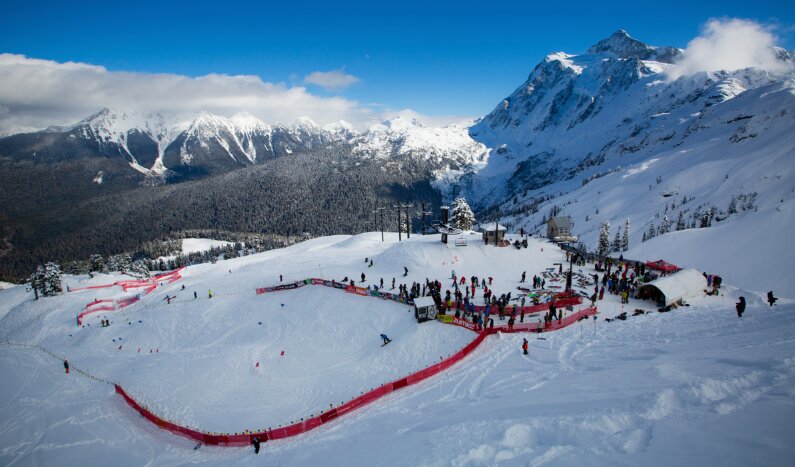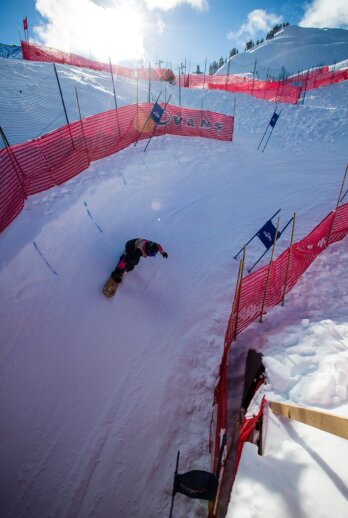
Photos by Ryan Duclos
The history of the Legendary Banked Slalom mirrors the history of snowboarding. The annual snowboard race at Mt. Baker Ski Area celebrates 30 years going strong this weekend.
Back when boards had fins and only went in one direction, snowboarding wasn’t allowed at most ski areas. “Snowboard boots” didn’t exist and bindings required copious amounts of duct tape. It was a new method of sliding down snow that the mainstream saw as crazy, stupid or dangerous, but that didn’t stop a growing number of northwesterners, influenced by the skate, surf and BMX culture of the late ’70s, from carrying their boards into the Cascades and riding untracked powder.
Jeff Fulton was one of the first people in Washington state to get addicted to snowboarding. His parents owned Fulton’s Schwinn Cyclery in Mount Vernon, and when the four snowboards in the Mount Vernon shop didn’t sell because no one knew what to do with them, Fulton grabbed the boards and a few friends to try them out. Fulton, Dan Donnelly, and Craig Kelly, all from Mount Vernon, formed an unofficial group of Mt. Baker snowboarders called the Mt. Baker Hard Core (MBHC) along with Eric Swanson, Carter Turk and Eric Jenko.
Unlike other ski area owners, Mt. Baker Ski Area general manager Duncan Howat saw no reason to ban the sport.
“He had always been active and into doing crazy stuff. He did motocross, he would waterski on plywood disks and do all kinds of ridiculous stuff,” said Duncan’s daughter Amy Howat Trowbridge, who is the director of marketing for Mt. Baker Ski Area. “He tried snowboarding and loved it.”
In the early ’80s, the MBHC was improving and growing, and riders wanted a venue to test their skills against snowboarders from other regions. Bob Barci, a northwest snowboarding pioneer, provided the Mt. Baker riders with snowboards out of his Bikefactory shop in Bellevue, and he formed the Bikefactory Snowboard Team.
Fulton had seen a snowboarding contest in Tahoe, and he and his friends came up with the idea to hold a race in a gully that forms a natural halfpipe on Mt. Baker’s White Salmon run.
“We came from a skateboarding background. In skateboarding you’re getting up on vertical walls in halfpipes and bowls. It made sense to hold a slalom race that allowed you to make that banked turn,” Fulton said. “It kind of embraced the spirit of snowboarding more than a flat course would.”
Around the same time, Tom Sims, a snowboard manufacturer from California, was looking for a place to hold a contest and promote the fledgling sport. Most Baker riders were on Sims boards, and Sims was known as the best snowboarder in the world at the time.
Fulton, Barci, Sims and the Mt. Baker Hard Core riders approached Howat in 1984, and the first banked slalom was held in February 1985. That first year it was called the Sims Open. Sims won, and Terry Kidwell (dubbed “the father of freestyle snowboarding”) came in second. Ken Achenbach, inventor of baseless bindings and founder of the Camp of Champions in Whistler, came in third. Kelly came in fourth, and he would go on to become one of the most influential snowboarders of all time.
The Mt. Baker Banked Slalom quickly became legendary in the snowboarding world. It became an annual staple, and the best riders from all over the world have come to compete ever since.
Trowbridge received her first snowboard in 1985 at the age of 13, when Sims gave the Howats two SE Pros as a thank-you for hosting the race. She won the pro-women category in 1987 and 1990, and she still has her first board.
“It’s a swallowtail with a fin and it was a great powder board, but it was hell on hardpack,” she recalled. “It was hard to ride snowboards back then. Everybody had really strong calf muscles, because bindings didn’t have backs and people were riding in high-topped tennis shoes and Sorel boots. The really cool thing to do was take out the liners of the Sorels, put ski boot liners in them and then duct tape everything together. Every snowboarder went through, I don’t know, 20 rolls of duct tape a year.”
With improvements to equipment, snowboarding gained popularity throughout the ’80s. In the early ’90s, the snowboarding craze reached a frenzied pitch and things got weird for a year or two.
“There was this bubble when money and competition were really huge in snowboarding and media perception was really hyped. These big tours came to Mt. Baker and handed out big checks for first prize,” Trowbridge said. “They wanted live television coverage and this and that, and they didn’t realize that we’re in the boondocks. It was a total fiasco.”
The race organizers decided to ditch the big money, keep the event in house and keep sponsorship within the snowboarding industry. The decision to stick to the roots of snowboarding is what has made the event truly legendary. Instead of giant checks, winners get a duct-tape trophy, an embroidered Carhartt jacket, a Pendleton blanket and an original piece of artwork from a northwest artist. Artists such as Jamie Lynn, an original Mt. Baker Hard Core rider and world-famous freestyle snowboarder, have contributed artwork.
Favoring authenticity over big money, the Legendary Banked Slalom remains the gathering of the global snowboarding tribe to this day. The list of winners includes the sport’s biggest names: founding fathers such as Sims, Kelly and Shaun Palmer, freestyle master Terje Haakonsen, Olympians Maëlle Ricker and Seth Wescott, and big mountain slayers Xavier De le Rue, Lucas Debari and Maria Debari.
Despite the LBS’ prestigious attendees, all are equal on race day. The local shredder who washes dishes in the lodge for a season pass can ride the lift with Travis Rice and achieve eternal glory if they make it through qualifiers and put up a winning performance in the finals. The course is the great equalizer.
“It’s a tough course,” Fulton said. “Conditions from year to year can be anything from slushy to pow to ice, or you may end up dealing with all those conditions in one weekend. Ruts start to form, and with the length of the course and the banked turns, it’s really tough on the legs. If you’re serious about winning, you’re training for it.”
Standing in the start gate at the top of the course is notoriously nerve-wracking. An inscription on the start shack reminds you to, “Say your prayers.” So what’s the secret to winning?
“Everybody always says, stay low and be powerful,” Trowbridge said.
“Find your groove and stick with it through the whole course,” Fulton said
This year marks the 30th anniversary of the Legendary Banked Slalom, and organizers, along with the rest of the snowboarding world, are “super excited” to put on a great race and celebration, Trowbridge said. However, an exceptionally warm winter has put the damper on preparations*. Normally scheduled for mid February, the 2015 LBS was rescheduled for March 19-22 in hopes of more snow to fill in the natural halfpipe.
With the dismal snow conditions this year, the term “Say your prayers” has taken on new meaning. “We’re hoping for a big March and keeping our fingers crossed,” Fulton said, reflecting the thoughts of the entire northwest ski and snowboard community. “It’s been a tough winter, but we’re all just trying to suck it up, wait it out and hope for more snow.” x
UPDATE: The 30th Legendary Banked Slalom celebration was postponed last year because of the lack of snow. This year (2016), the snowpack is looking good and the 30th LBS is on for February 18–21 at Mt. Baker Ski Area. Check http://lbs.mtbaker.us/ for more info.